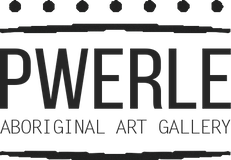You have no items in your cart. Want to get some nice things?
Go shopping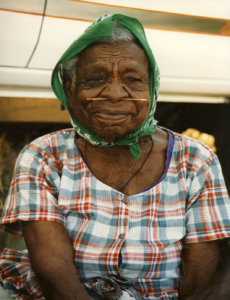 D.O.B: 1910-1996
D.O.B: 1910-1996
LANGUAGE GROUP: Alyawarre
COMMUNITY: Utopia, NT
Born in about 1910 at Alhalkere, Emily Kame Kngwarreye was a respected Eastern Anmatyerre elder who in a meteoric rise to fame became a world renowned artist at Utopia in Central Australia. She first saw white people at the age of about nine and worked as a stock hand on pastoral properties at a time when Aboriginal women were usually only employed as domestics on the stations. It is a testament to Emily’ s extraordinary spirit and character that in the eight years before she died in 1996, she painted a remarkable 3000 paintings on canvas and came to be recognised as Australia’s most famous artist.
Emily was a senior Law woman and taught generations of Utopia women the songs, dances an body painting of awelye, women’ s business. Her principal Dreaming for atnwelarr yam was given to her by her father and her name Kame means yam seed. The perennial yam plant has bright green creeping leaves, yellow flowers and white seeds, and the underground tuber is a staple food that Anmatyerre and Alyawarre women still dig for and collect at Utopia. She painted all these different aspects of the yam. Through Aboriginal kinship relationships she also had other Dreamings, including emu (ankerrre) and a favourite plant food of the emu (intekwe).
Through a community arts project in 1977 at Utopia, Emily began working in batik and for a decade exhibited her batik paintings with other Utopia women. But when given acrylics and canvas in 1987 she preferred the ease and spontaneity the new medium allowed her. Her first canvas was exhibited at the S. H. Ervin Gallery in Sydney in ‘A Summer Project 1988 1989’ and she immediately received widespread acclaim and recognition. Her technique was always highly individual, beginning with drawings that she then covered with complex layers of dots. When she began to paint awelye body painting designs onto canvas, she created a new linear style to express gestures that for decades she had drawn in ochre on women’ s bodies in preparation for dancing.
Emily’ s pleasure in working as an artist was reflected in her love of exuberant colours and her energetic and expressive compositions using both dots and lines. With great innovative flair she would cut her brushes down and fill them with acrylic paint to make distinctive dots that turned into fields of wildflowers on canvas. She worked in many different styles but her subject matter always reflected her Alhalkere country for which she was a custodian.
In 1990, Emily’ s work was shown in two highly successful solo shows in Sydney, as well as the Art Gallery of New South Wales’ ‘Abstraction’ exhibition. Later that year, she participated in the CAAMA/Utopia ‘Artists in Residence’ program at the Institute of Contemporary Art, Perth. Several solo shows followed including Gallery Gabrielle Pizzi, Melbourne 1990 and 1991 and Utopia Art, Sydney in 1991 and 1992. Her work was rapidly acquired by major public and private collections in Australia and overseas and was keenly sought after. In just three years, her paintings were shown in 48 group exhibitions around Australia and internationally in Ireland, Russia, the Ukraine, Latvia, Japan and the United States of America.
In 1992, Emily was awarded a prestigious Australian Artists Creative Fellowship. Her work was shown in the ‘Joan and Peter Clemenger Triennial Exhibition of Contemporary Australian Art’ at the National Gallery of Victoria in 1993. Major solo exhibitions followed and in 1998 and 1999 retrospectives of her work were shown at the Queensland Art Gallery, the Art Gallery of New South Wales and the National Gallery of Victoria, and in Japan in 2008. Her work is now widely exhibited throughout Australia, Japan and many European cities such as London and Dusseldorf.
Emily Kame Kngwarreye was the most lauded painter of the Utopia art movement to date and one of the best known of all the desert artists, painting with an undiminished energy that belied her years. She made an immense impact on the art world and continues to be an inspiration to generations of Indigenous artists. Emily died on September 2nd, 1996 and left behind an incredible legacy, for her magnificent paintings provide a bridge between cultures and delight all who see them.
She has been dearly missed by our family ever since.
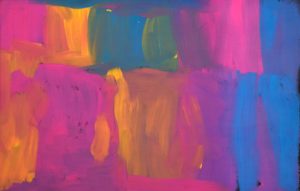
The creation of the “Final Series”
During the eight years of her remarkable career and meteoric rise to fame as Australia’s most famous female artist, the late Emily Kame Kngwarreye painted over 3000 canvases. All were celebrations of her country of Alhalkere, her Yam Dreaming and women’s ceremonial awelye body painting designs for the atnwelarr yam. In August 1996, in her mid to late eighties and in poor health, Emily summoned Fred Torres, her great-nephew in Aboriginal Law and Director of DACOU to Utopia because she wanted to paint. Despite Fred’s reluctance to have this aged artist risk her health even further, Emily’s insistence and authority as always prevailed.
Sitting cross-legged on the ground at a bush camp, Emily asked for canvas and acrylic paints to be brought to her. Fred began to unroll the canvas and set up jars of paint. To his chagrin he discovered that he had not brought her usual size brushes but only a very broad gesso brush that was normally used to paint a first coat of black on the white canvas to signify her skin colour. While Fred was debating what to do, Emily simply picked up the gesso brush and painted a huge single-coloured area of acrylic on the canvas on the ground in front of her. Before he could say anything, she once again dipped the gesso brush in a different colour and painted another broad portion of the canvas. In no time at all the first small canvas was completed, and Emily, with gesso brush dripping paint, was ordering Fred to bring her another canvas.
Over the following days Emily painted twenty-three other canvases in this style. These paintings were completely unlike any Emily had produced before. She filled canvases with broad sweeps of her brush to create fields of light, space and exuberant colour, dispensing with dots and lines altogether. With crimsons, scarlets, rich purple-mauves and red-browns, she juxtaposed high key variations of the red sandy earth of Alhalkere. Some of the paintings were comprised of large minimal passages of subtle pastel whites that echoed the white of her namesake kame, yam seed, her main Dreaming while the yam’s yellow flowers now shone in lemon and cadmium yellows.
The ceremonial red ochre with which Emily had painted the ceremonial awelye women’s body painting designs on her Anmatyerre countrywomen’s breasts, shoulders and torsos found its acrylic correspondence in bright pinks and orangey reds.
Fred realised that he was witnessing another extension of Emily’s creative ability and duly documented each piece by photograph. What amazed him even more was that she seemed re- energised and painted not only twenty-four of these works, but several Yam Dreaming and awelye paintings as well. Fred returned to Adelaide and immediately unrolled the canvases in his DACOU Gallery. Several people witnessing the first unveiling were spellbound by the bright hues of colour emanating from the canvases. From these initial reactions Fred knew that these would become very important artworks and much discussed.
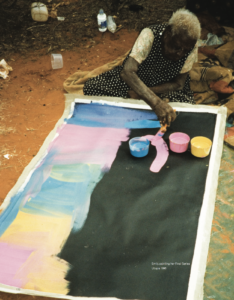
Emily died in Alice Springs on the 2nd of September 1996. After her death, as people grieved for the loss of this great artist, it became increasingly clear that this elderly Anmatyerre senior Law woman had made an enormous impact on the art world. It was only fitting that a major curated retrospective exhibition of her work would be shown in each prestigious Australian State Art Gallery, beginning with The Queensland Art Gallery. Five paintings were chosen from Emily’s ‘Final Series’, a fitting tribute to her magnificent creative spirit that was still in evidence during the last days of her life. Judith Ryan, Senior Research Curator of Australian Art at the National Gallery Of Victoria, wrote of these paintings: “Having exhausted all possible use of multiple round or long marks, Kngwarreye eliminated them all together, expanding her brush marks into broad blocks of tone and colour until she re-invented herself” (Judith Ryan in Emily Kame Kngwarreye – Alhalkere – Paintings from Utopia, retrospective exhibition catalogue, co-published by Queensland Art Gallery and Macmillan Publishers Australia, 1998, p. 45). Christopher Hodges of Utopia Art also paid tribute to these works: “Kngwarreye at this late stage took a new tack and created, with barely one coat of paint, fields of colour that are beguiling in their simplicity. The sureness of these paintings is absolute” (Christopher
Hodges in Emily Kame Kngwarreye – Alhalkere – Paintings from Utopia, retrospective exhibition catalogue, co-published by Queensland Art Gallery and Macmillan Publishers Australia, 1998, p. 38).
As Emily painted her final series, she repeatedly gestured to the land around her, saying “Alhalkere”, the name of her country for which she was custodian. Her connection to Alhalkere was total and profound. With great painterliness she conveyed the essence of the land with a sense of numinous spaciousness. These great artworks can be seen as a final expression of Alhalkere, her remarkable spirit and a draining away, a kenosis. In this last series, Emily merged self and country in a dissolution of form.
The echoes of Emily softly singing the songs of Alhalkere can still be heard in her paintings today. Her life continues to be an inspiration to generations of indigenous artists, not just at Utopia, but throughout Australia. Her paintings provide a bridge between the cultures and delight all who see them, offering tantalising clues to a more holistic and embodied way of being on this earth.
© Dr. Victoria King 2009
“Yam Dreaming”
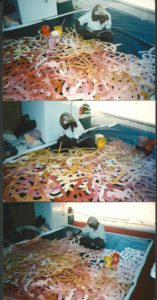
The renowned late Anmatyerre artist Emily Kame Kngwarreye’s name, Kame, means yam seed, akam, and during the last eight years of her life she painted the yam in all of its cyclical manifestations. Through paternal lineage, yam was her major Dreaming story for her country of Alhalkere near Utopia. Emily’s later years were spent living at Utopiai at Alparra, the country of her mother and second husband, 270 kilometres north-east of Alice Springs in the Northern Territory where about one thousand Anmatyerre and Alyawarre people live on fifteen Aboriginal outstations on 1500 kilometres of semi-arid land.
Aboriginal women artists’ subject matter is determined by Aboriginal Law, as it is for men, and secret/sacred distinctions about Dreamings determine the content of what can and cannot be painted. Ownership of a Dreaming is always specific, and artists paint what is culturally appropriate through their relationship to their country and kinship connections. Yet as Emily masterfully demonstrated in her extraordinary prolific creative legacy, the possibilities for visual innovation are immense. To ‘hold’ or to ‘own’ a Dreaming is also to be ‘held’ or ‘owned’ by it, and this concept of custodianship has secular and sacred implications. In a comment whose magnitude is difficult to comprehend, Emily frequently said, “I am akam”. When Emily began to work in batik then in acrylics on canvas, she was able to use these new hybrid mediums to impart knowledge of the yam and her country to young Anmatyerre and Alyawarre women, as well as to inspire them with possibilities for their own lives as artists.
With spontaneity and creativity Emily painted all the different characteristics of the perennial atnwelarr yam (Vigna lanceolata), an underground tuber and staple food that the women still dig for and collect at Utopia. She enthusiastically filled canvases with colourful dots and lines that expressed the yam’s tiny white seeds, yellow flowers and bright green creeping leaves, the winding underground growth of its tubers, as well as the tracks and cracking network of dried earth that reveals its presence. The Utopia artist Barbara Weir1 described the importance of Yam Dreaming in Emily’s paintings:
Akam, yam seed, her father gave her that name. The truth is she always painted the same thing, about the yam. She painted the yam roots, the yam flowers after the rain, the seeds of the yam, and the body paint of the yam. But it was nothing but the yam she painted. A couple of times she painted the emu woman, but her story, and I know because she was speaking Anmatyerre language to me all the time and I know the story, it’s all to do with the yam. Emu is her Dreaming, too, but her story was yam (Barbara Weir, interview with Victoria King, 1999, Utopia).
Emily’s cultural and experiential knowledge of her Yam Dreaming and her country of Alhalkere were all-encompassing. With her distinctive dotting she created vast fields of yam flowers whose colours reflected subtle and vibrant seasonal changes on her country. She began to more prominently use linear gestures to suggest the cracking of the sun-baked red earth and the women’s repeated arm motions as they break the compacted ground with digging sticks to collect yams. These audacious new lines reflected the gestalt of both the yam’s underground growth and awelye, women’s
_________________________________
The lives of Barbara Weir and her son Fred Torres, director of DACOU, the Aboriginal family-owned Dreaming Art Centre of Utopia galleries, are intertwined with Emily’s through the extensive time Barbara spent with Emily at Utopia. Emily was like a second mother to Barbara, and while collecting water for her at the age of nine, Barbara was suddenly seized by authorities and taken away to become a member of the Stolen Generation. Her family thought she was dead. Twelve years later in 1968 it was Emily who warmly welcomed Barbara back to Utopia. Barbara returned with a hard-won command of English that would prove to be instrumental in Utopia’s long fight for Land Rights. In 1981 Utopia was the first pastoral station in Australia to be successfully claimed by Aboriginal people, a turning point for the whole Land Rights movement.
_________________________________
ceremonial body painting. As a respected elder and Law woman for her country of Alhalkere, she taught young Anmatyerre girls the songs and dances of awelye for her Yam Dreaming. The awelye body painting designs on her canvases resonated with the ochre lines painted on women’s breasts, shoulders and torsos in preparation for dancing. She collected ochres from the land to grind into pigment for awelye and also used them for a few special paintings on canvas.
When Emily was about nine years old she first saw a white man while digging for yams at Alhalkere where she was brought up in a dry creek between sand hills. For traditional Anmatyerre and Alyawarre people of Emily’s generation, collecting bush tucker was once a matter of survival. Despite the widespread introduction of commercially available foods, yam is still collected and cooked by Utopia women. Through her Dreaming for it, Emily had a special understanding of this important food. Alice Springs ethnobotanist Peter Latz has worked extensively with the people of Utopia to catalogue their unique knowledge of native plants and their use of fire management. He found that the yam’s growth is encouraged by fire and grows after rain at any time of the year (Peter Latz, Bushfires and Bushtucker: Aboriginal Plant Use in Central Australia, IAD Press, Alice Springs, 1995, p. 296). This capacity of the yam to survive drought and fire makes it especially important as a food source as the tubers store water and plant nutrients. Latz described the atnwelarr (Vigna lanceolata):
The edible swollen roots of this plant are an important food source throughout its range. These juicy, starchy storage organs have a rather bland taste; they are either eaten raw or, more frequently, after being cooked in hot sand and ashes. The above-ground portion of this plant usually dies off a month or so after rain, and it is after this time that the yams are usually collected. Considerable skill is required to locate the underground portions of the plant at this stage, and involves both a knowledge of the specific habitat of the plant and an ability to recognise the remaining dry stems and leaves (ibid.).
Emily Kngwarreye’s culture holds enormous land-based knowledge, ecological understanding, cultural complexity and spiritual wisdom. Emily’s acknowledgement of herself as a personification of yam expresses a deep sense of reciprocity and relationship. Such a remarkable way of seeing and being is a profound mystery, as it suggests a spiritual dissolution of distance between ‘self’ and ‘other’. Emily’s commanding paintings communicate respect, reverence and custodianship, and celebrate her Yam Dreaming and country of Alhalkere, its beauty and the wisdom that its people hold.
Copyright to this biography belongs to Pwerle Gallery.
EXHIBITIONS:
2021 Reverence, D’Lan Contemporary, Melbourne.
2021 Abstraction, Utopia Art, Sydney.
2021 SIGNIFICANT, D’Lan Contemporary, Melbourne.
2021 Voyage across Aboriginal Australia – Founders’ Favourites, Fondation Burkhardt-Felder Arts et Culture, Moitiers, Switzerland.
2021 The Women’s Show | 15th Anniversary Exhibition, Vivien Anderson Gallery, Melbourne.
2021 We Choose to Challenge, Coo-ee Fine Art Gallery, Sydney.
2021 Big Names Little Paintings, Cooee Art Gallery, Sydney.
2020 From Little Things Big Things Grow, Kluge-Ruhe Collection, University of Virginia, Charlottesville, USA.
2020 Desert Painters of Australia – Two Generations, Gagosian Gallery, Hong Kong.
2020 Colours of Spring, Kate Owen Gallery, Sydney.
2020 Know My Name – Australian Women Artists 1900 to Now, National Gallery of Australia, Canberra.
2020 Important Australian Paintings, Philipp Bacon Galleries, Brisbane.
2020 Still in the Desert, Fireworks Gallery, Brisbane.
2020 Reflections on Emily and Papunya, High Line Nine Galleries, New York.
2020 Mapa Wiya (Your Map’s Not Needed): Australian Aboriginal Art from the Fondation Opale, The Menil Collection, Houston, TX, USA.
2020 Knowing my Name: Australian Women Artists 1900 to Now, Australian National Gallery, Canberra.
2019 Tiempo de Sonar, Museo Nacional de las Culturas del Mundo, Mexico-City, in cooperation with Coo-ee Gallery, Sydney.
2019 Beyond Time, Australian Aboriginal Art, Booker Lowe Gallery, Houston, TX, USA.
2019 Sydney Contemporary, Carriageworks, Sydney.
2019 Desert Painters of Australia, Larry Gagosian Gallery, New York, USA – from the Steve Martin & Anne Springfield Collections and Kluge-Ruhe Collection of the University of Virginia, USA.
2019 Significant, D’Lan Contemporary, Melbourne.
2018 Earth’s Creation, Kate Owen Gallery, Sydney, NSW.
2018 Painting on Country – Utopia Artists, Japingka Gallery, Fremantle, WA.
2018 Beyond the Veil, Olsen Gruin, New York.
2018 Significant, D’Lan Contemporary, Melbourne.
2018 20/20 Vision: 20 Years 20 Women, Brenda Colahan Fine Art, Sydney.
2017 A SWEEP continues, FireWorks Gallery, Brisbane.
2017 A SWEEP: Old & New Works, FireWorks Gallery, Brisbane.
2016 Important Australian Indigenous Art , D’Lan Contemporary, Melbourne.
2011 Up Close and Personal: works from the collection of Dr Peter Elliott AM, S. H. Ervin Gallery, Sydney.
2010 Desert Country, Art Gallery of South Australia, Adelaide.
2010 Minnie Pwerle & Emily Kame Kngwarreye, Kate Owen Gallery, Sydney.
2010 Gooch’s Utopia: collected works from the Central Desert, Flinders University touring exhibition, Art Gallery of Macquarie University, Sydney.
2009 ‘Utopia: Colours of the Desert’, Gongpyeong Art Space in conjunction with DACOU, Australian Embassy in Korea and Crossbay Gallery, Seoul, Korea.
2009 Size Matters, Kate Owen Gallery, Sydney, NSW.
2009 Mythology & Reality: Contemporary Aboriginal Art From The Gabrielle Pizzi Collection, TarraWarra Museum of Art, Healesville, VIC.
2009 ‘Emily Kame Kngwarreye: The Person and Her Paintings’, DACOU, Port Melbourne.
2009-1999 Numerous solo exhibitions held around the country by various galleries and auction houses.
2008 ‘More Than Stories’, Utopia Art, Sydney.
2008 ‘Utopia: The Genius of Emily Kame Kngwarreye’, retrospective exhibition, Osaka Museum of Art and Art Centre of Tokyo, Japan.
2007 ‘Standing on Ceremony’, Tandanya Cultural Institute, Adelaide.
2007 ‘Treasures of the Spirit: Investing in Aboriginal Art’, Tandanya Cultural Institute, Adelaide.
2000 Numerous exhibitions held by various galleries, including:
2000 Utopia exhibition at the AMP building, Sydney, organized by DACOU in association with AMP, an official Sponsor of the Sydney 2000 Olympic Games.
2000 Group Utopia art exhibition at Mary Place Gallery, Sydney.
1999 Numerous exhibitions held around Australia, including: ‘Utopia’, BMG ART, Adelaide.
1999 ‘Emily Kame Kngwarreye: Alhalkere Paintings from Utopia’, National Gallery of Australia, Canberra (13 February to 26 April).
1998 Numerous exhibitions around Australia, including: ‘The Ladies Of Utopia’, Chapman Gallery, Canberra.
1998 ‘Utopia V’, Quadrivium Gallery, Sydney.
1998 Group exhibition at Flinders Lane Gallery, Melbourne. Group exhibition at FireWorks Gallery, Queensland.
1998 Group exhibition at DACOU, Adelaide.
1998 Group exhibition at Gallery Savah, Sydney.
1998 ‘Emily Kame Kngwarreye: Alhalkere Paintings from Utopia’, a collection of 89 works in an exhibition of 192 pieces curated by Queensland Art Gallery, the first public institution to comprehensively profile Emily’s artwork.
1998 Queensland Art Gallery (20 February to 13 April)
1998 Art Gallery of New South Wales (15 May to 19 July)
1998 National Gallery of Victoria (8 September to 22 November).
1998 ‘Emily Kame Kngwarreye’, Gallery Savah, Sydney.
1998 ‘Earth’s Creation: The Paintings of Emily Kame Kngwarreye’, Lauraine Diggins Fine Art, Melbourne.
1998 ‘Emily Kame Kngwarreye’, Mary Place Gallery, Sydney, featuring paintings from Emily’s final series with all artworks supplied by DACOU.
1998 ‘Emily Kame Kngwarreye: The Spirit Sings’, Tandanya Cultural Institute, Adelaide, an exhibition of 89 paintings supplied by DACOU and associates.
1996 ‘Framed’, Emily Kngwarreye and Trevor Nickolls.
1996 The Darwin Gallery, Darwin.
1996 ‘Utopia Artists’, DACOU, Adelaide.
1996 ‘Emily Kame Kngwarreye’, Gallery Savah, Sydney.
1996 ‘Emily Kame Kngwarreye’, Flinders Lane Gallery, Melbourne.
1996 ‘Emily Kame Kngwarreye’, Fire Works Gallery, Brisbane. ‘Emily Kngwarreye’, Chapman Gallery, Canberra.
1995 ‘Emily Kame Kngwarreye: Recent work 1993-1994’, William Mora, Melbourne.
1995 ‘Dreaming: Emily Kame Kngwarreye, Barbara Weir, Gloria Petyarre and other Utopia artists’, DACOU, Adelaide.
1995 ‘Ian Fairweather and Emily Kame Kngwarreye’, Niagara Galleries, Melbourne.
1995 ‘Emily Kame Kngwarreye: Recent works 1994-1995’, DACOU, Adelaide.
1994 ‘Identities: Art from Australia’, Taipei Fine Arts Museum, Taiwan. Woollongong City Art Gallery.
1994 ‘The Oval Paintings Collection’, Bishop Museum, Hawaii.
1994 ‘Desert Painting’, Fire Works Gallery, Brisbane.
1994 ‘Yirbana: An Introduction to the Aboriginal and Torres Strait Islander Collection’,
1994 Art Gallery Of New South Wales, Sydney.
1994 ‘Ink Lines: Mapping the Printer’, Coo-ee Aboriginal Art, Sydney.
1994 ‘This Land: A Celebration’, Utopia Art, Sydney.
1994 ‘New Directions’, Utopia Art, Sydney.
1994-93 ‘Flash Pictures’, National Gallery of Australia, Canberra.
1994-93 Tandanya National Aboriginal Cultural Institute, Adelaide.
1993 ‘Trevor Nickolls, Emily Kame Kngwarreye, Ginger Riley, Munduwalawala and Rover Thomas’, Hogarth Gallery, Sydney.
1993 ‘Contemporary Aboriginal Art from the Robert Holmes à Court Collection’, Moree Plains Gallery, Moree.
1993 ‘Joan and Peter Clemenger Triennial Exhibition of Contemporary Australian Art’, National Gallery of Victoria, Melbourne.
1993 ‘After The Field: A Contemporary Abstraction’, Utopia Art, Sydney.
1993 ‘A Private Collection’, Chandler Coventry, Campbelltown City Art Gallery, Campbelltown.
1993 ‘Aratjara: Art of The First Australians’, Kunstsammlung; NordrheinWestialen, Dusseldorf; Louisiana Museum, Humlebaek.
1993 Hayward Gallery, London.
1993 Scarf-Greenaway Gallery, Hyde Park Barracks, Sydney.
1993 ‘Tjukurrpa: Desert Dreamings: Aboriginal Art From Central Australia 1971-1993’, Art DownUnder, De Ontelbare Doom.
1993 Museum Dhondt-Dhaenens, Deurle, Belgium.
1993 Gallery of Western Australia, Perth.
1993 ‘The Alhalkere Suite’, Utopia Art, Sydney.
1993 ‘Recent Paintings by Emily Kame Kngwarreye’, Gallery Gabrielle Pizzi, Melbourne.
1993 ‘Emily Kame Kngwarreye’, Hogarth Gallery, Sydney.
1992 ‘Crossroads: Toward a New Reality: Aboriginal Art from Australia’, National Museum Of Modern Art, Kyoto and National Museum Of Modern Art, Tokyo.
1992 ‘Contemporary Aboriginal Art from the Robert Holmes à Court Collection, Perth Institute Of Contemporary Art, Perth.
1992 ‘Bubbles, Baubles and Beads’, Utopia Art, Sydney.
1992 ‘ACAF3: Third Australian Contemporary Art Fair’, Royal Exhibition Buildings, Melbourne.
1992 ‘Aboriginal Art: Utopia in the Desert’, Nogazaka Arthall, Tokyo.
1992 ‘My Story, My Country: Aboriginal Art and the Land’, Art Gallery of New South Wales, Sydney.
1992 ‘Aboriginal Art from Australia’, The National Museum Of Modern Art, Tokyo. ‘Nineteen Ninety-Two: New Work’, Utopia Art, Sydney.
1992 ‘Aboriginal Painting from the Desert’, State Ethnographic Museum, St. Petersburg, Russia; Ukraine; State Byelorussion; Museum of Modern Art, Minsk, Byelorussion; Riga, Latvia.
1992 Gallery Gabrielle Pizzi, Melbourne.
1992 ‘Alhalkere’, Utopia Art, Sydney.
1992 ‘Emily Kame Kngwarreye’, Gallery Gabrielle Pizzi, Melbourne.
1991 ‘Central Australian Aboriginal Art and Craft Exhibition’, Araluen Arts Centre, Alice Springs.
1991 ‘Aboriginal Women’s Exhibition’, Art Gallery of New South Wales, Sydney. ‘Utopia Batik’, Utopia Art, Sydney.
1991 ‘Utopia’, Utopia Art, Sydney.
1991 ‘Aboriginal Art and Spirituality’, The High Court of Australia, Canberra; Parliament House, Canberra; The Exhibition Gallery, Waverley City Gallery; Ballarat Fine Art Gallery.
1991 ‘Images Of Women’, S. H. Ervin Museum, Sydney.
1991 ‘A Picture Story’, Meat Market Craft Centre, Melbourne.
1991 ‘Australian Aboriginal Art from the Collection of Donald Kahn’, Lowe Art Museum, University of Miami, Florida.
1991 ‘Aboriginal Painting from the Desert’, Union Gallery, Moscow.
1991 ‘Through Women’s Eyes’, ATSIC Traveling Exhibition.
1991 ‘Emily Kame Kngwarreye’, Utopia Art, Sydney.
1991 ‘Emily Kame Kngwarreye’, Gallery Gabrielle Pizzi, Melbourne.
1991 ‘Emily Kame Kngwarreye’, Hogarth Gallery, Sydney.
1990 ‘The Last Show’, Utopia Art, Sydney.
1990 ‘Abstraction’, Art Gallery Of New South Wales, Sydney.
1990 ‘Contemporary Aboriginal Art from the Robert Holmes à Court Collection’, Carpenter Centre for the Visual Arts, Harvard University; James Ford Bell Museum, University of Minnesota; Lakewood Centre of the Arts, Lake Oswego Forum, St. Louis, Missouri, USA.
1990 ‘Painting from the Desert: Contemporary Aboriginal Paintings’, Plimsoll Gallery, University of Tasmania, Hobart.
1990 ‘New Acquisitions’, National Gallery Of Victoria; ARCO, Madrid.
1990 ‘CAAMA/Utopia Artists in Residence Project’, Perth Institute of Contemporary Art. ‘ACAF2: Second Australian Art Fair’, Royal Exhibition Buildings, Melbourne. ‘Utopian Artists’, Flinders Lane Gallery, Melbourne.
1990 ‘New Year, New Art’, Utopia Art, Sydney.
1990 ‘Utopia: A Picture Story’, 88 silk batiks from the Robert Holmes à Court Collection, Tandanya National Aboriginal Cultural Centre, Adelaide; The Royal Hibernian Academy, Dublin, Ireland; The Museum of Contemporary Art, Sydney.
1990 ‘Emily Kame Kngwarreye’, first solo exhibition, Utopia Art, Sydney.
1990 ‘Emily Kame Kngwarreye’, Coventry Gallery, Sydney.
1990 ‘Emily Kame Kngwarreye’, Gallery Gabrielle Pizzi, Melbourne. ‘Emily Kame Kngwarreye’, Hogarth Gallery, Sydney.
1989 ‘Utopia Women’, Coventry Gallery, Sydney in association with Utopia Art, Sydney. ‘Art from Utopia’, Austral Gallery, St. Louis, Missouri, USA.
1989 ‘A Summer Project’, S.H. Ervin Gallery, Sydney.
1989 Orange Regional Gallery, Orange, New South Wales.
1989 ‘Utopia Batik’, Araluen Arts Centre, Alice Springs.
1989 ‘Mythscapes: Aboriginal Art of the Desert’, National Gallery of Victoria, Melbourne. Gallery Gabrielle Pizzi, Melbourne.
1988 ‘Contemporary Aboriginal Art’, Utopia Art, Sydney.
1988 ‘A Changing Relationship’, S. H. Ervin Gallery, Sydney.
87-77 Batik exhibitions with Utopia women in Australia and abroad.
COLLECTIONS:
National Gallery of Australia, Canberra.
National Gallery of Victoria, Melbourne.
Art Gallery of New South Wales, Sydney.
Art Gallery of Western Australia, Perth.
Queensland Art Gallery, Brisbane.
Benalla Art Gallery, Victoria.
Artbank, Sydney.
Donald Kahn Collection, Lowe Art Museum, University of Miami. Fred Torres Collection, Adelaide.
K.L.M. Royal Dutch Airlines, Amsterdam.
University of Sydney Union, Sydney.
Kelton Foundation, Los Angeles.
The Robert Holmes à Court Collection.
The Araluen Arts Centre, Alice Springs.
Auckland City Art Gallery, New Zealand.
Coventry Collection, Sydney.
The Elton John Collection.
The Vatican Collection, Rome.
See below some of her beautiful pieces for sale:
-
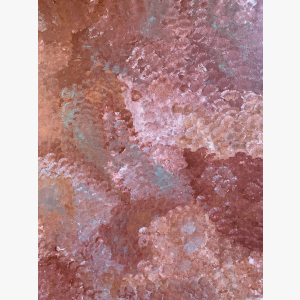 Emily Kame Kngwarreye ‘PG7197117’
Emily Kame Kngwarreye ‘PG7197117’ -
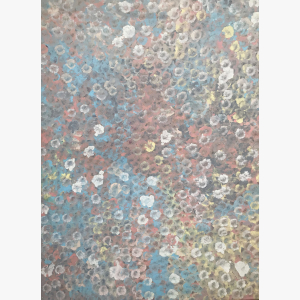 Emily Kame Kngwarreye ‘6184’$28,000.00
Emily Kame Kngwarreye ‘6184’$28,000.00 -
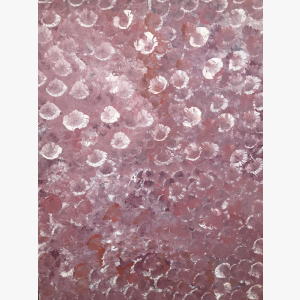 Emily Kame Kngwarreye ‘PG2211’$3,300.00
Emily Kame Kngwarreye ‘PG2211’$3,300.00 -
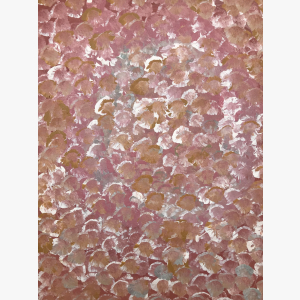 Emily Kame Kngwarreye ‘PG2210’$3,300.00
Emily Kame Kngwarreye ‘PG2210’$3,300.00
